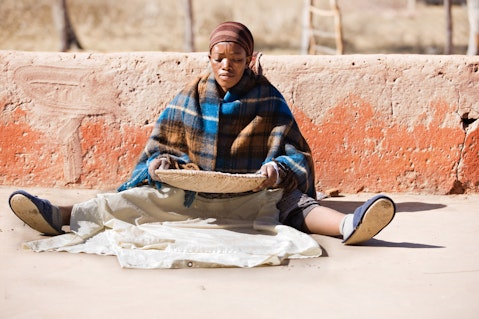In this article, we will list poor countries with substantial debt, and discuss the role of foreign corporations in allievating poverty in these countries. If you want to skip the details, head straight to 10 Heavily Indebted Poor Countries.
Heavily Indebted Poor Countries (HIPC) are trapped in a debilitating cycle of debt and poverty, worsened by weak governance, economic mismanagement, and external policies like limitations in debt allocation. Predominantly located in Africa, many of these countries remain impoverished despite being rich in natural resources; there’s gold in Mali, Tanzania, the Democratic Republic of Congo, and Cote d’Ivoire, for example. The wealth generated from these resources is often drained away from these economically fragile states, leaving the majority impoverished in these Least Developed Countries in Africa.
Another significant source of adversity for these deeply indebted low-income countries is their reliance on low-productivity sectors, such as agriculture, with negligible diversification into manufacturing and services. Most of these nations’ labor force is engaged in the informal economy, which, although provides livelihoods, offers low wages, scant job security, and negligible social protection. These challenges, compounded by climate issues, corruption, and political conflicts, plunge these economically distressed indebted countries further into poverty, necessitating substantial external debts.
Corporates Investing In Heavily Indebted Poor Countries
Mining is a crucial economic growth driver in many nations with excessive debt loads, with corporate investments playing a pivotal role in their future economic prospects. For example, Barrick Gold Corporation (NYSE:GOLD) is a significant stakeholder in gold mining in Heavily Indebted Poor Countries (HIPCs) and some lower-middle-income countries like Pakistan. The company operates gold mining ventures in Tanzania, Mali, and the Democratic Republic of Congo. The corporation’s gold operations in HIPCs supply approximately 17.73 million ounces of gold to its reserves.
In Pakistan’s case, Barrick Gold Corporation owns 50% of Pakistan’s Reko Diq gold-copper project and plans to extract the first gold concentrate by 2028. According to the company’s Q2 2023 earnings call, it aims to initiate economic activity around Reko Diq and provide employment opportunities to help lift locals from poverty. The company has implemented the same around the Kibali gold mine in the Democratic Republic Of Congo by educating the future operators of the mine ahead of time and then employing them to increase its workforce reliability.
In preparation for gold mining commencement in Pakistan, Barrick Gold Corporation (NYSE:GOLD) has already contracted some locals studying in universities, focusing on engineering and processing. These individuals will receive training at Barrick Gold Corporation’s operations around the world with the intention that they will be the leaders of the operation when the company starts its gold mining operations in Pakistan in a few years’ time. The company plans to employ 7500 people for this project in Pakistan, 4000 of which will be long-term jobs.
Through strategic investments and planning, Barrick Gold Corporation (NYSE:GOLD) has already transformed Mali’s Loulo-Gounkoto gold mine into one of the world’s ten largest gold mining complexes. Consequently, Loulo-Gounkoto has become one of Mali’s principal hub for economic activity, employing approximately 7000 individuals, 97% of whom are Malian.
In a different sector, Microsoft Corp (NASDAQ:MSFT) has also launched initiatives in impoverished countries, with philanthropic efforts focused on expanding access to digital technology, education, and job skills in nations grappling with high poverty rates. With around 2.7 billion people globally lacking internet access (most residing in Africa), Microsoft Corp (NASDAQ:MSFT)’s Airband Initiative aims to bridge this gap, planning to provide internet access to 250 million individuals (including 100 million Africans) by 2025. This access facilitated by Microsoft Corp (NASDAQ:MSFT) will empower residents by providing online education and economic opportunities, thereby contributing to the improved economic prospects of these countries with the highest rates of poverty.
Such empowerment, whether in terms of enhanced connectivity or regional infrastructure development, eventually results in these poor countries’ better economic future.
On that note, let’s now move to heavily indebted underdeveloped nations.

30 Heavily Indebted Poor Countries
Our Methodology
We compiled a list of heavily indebted poor countries by considering each nation’s external debt stocks, GNI per capita, and percentage of population living in extreme poverty. This data was sourced from the United Nations’ World Economic Situation & Prospects 2023 update, The World Bank’s International Debt Report 2022, and The World Bank’s databases on GNI per capita and extreme poverty ratio. After quantifying these nations’ external debt, GNI per capita, and extreme poverty levels, we averaged (with debt having the highest weight) their rankings to derive composite results. The countries were then listed in ascending order based on their economic burden.
Based on our findings, here are the top countries facing severe debt challenges:
30. Sierra Leone
External Debt Stocks: $2.453 billion
GNI Per Capita: $1900
Below $2.15 Poverty Rate: 26.1 %
Composite Ranking: 30
Sierra Leone’s economy, fragile due to an overreliance on the mining sector, is vulnerable to global price fluctuations. Despite abundant resources, the nation faces high unemployment and pervasive poverty. This economic instability stems partly from rampant corruption, limited access to education, and insufficient foreign investment.
29. Haiti
External Debt Stocks: $2.694 billion
GNI Per Capita: $3310
Below $2.15 Poverty Rate: 29.2%
Composite Ranking: 29
Haiti possesses one of the Western Hemisphere’s weakest economies, with a GDP per capita of $1748. The nation is heavily dependent on remittances, which constitute over a quarter of its GDP. The scarcity of access to education and skilled labor hinders economic diversification and development, trapping the country in a cycle of debt and poverty.
28. Malawi
External Debt Stocks: $3.185 billion
GNI Per Capita: $1700
Below $2.15 Poverty Rate: 50.7%
Composite Ranking: 28
Agriculture, employing around 80% of the population, is the linchpin of Malawi’s economy. However, reliance on primary products like tobacco exposes the nation to international market price volatility. The agriculture sector is also highly susceptible to climate shocks. With a limited industrial base and persistent corruption stifling the private sector, the nation struggles to create sufficient jobs.
27. Togo
External Debt Stocks: $3.467 billion
GNI Per Capita: $2610
Below $2.15 Poverty Rate: 28.1%
Composite Ranking: 27
Togo’s economy, primarily based on subsistence agriculture, is vulnerable to climatic variations and has limited diversification, leading to reliance on expensive commodity exports. With a per capita GDP of only $918 and 28.1% of the population living on less than $2.15 a day, the economy remains weak.
26. Afghanistan
External Debt Stocks: $3.531 billion
GNI Per Capita: $1690
Below $2.15 Poverty Rate: 49.4%
Composite Ranking: 26
Afghanistan’s economy, scarred by decades of conflict and political instability, leans heavily on foreign aid, with a significant portion coming from the US (eventually topping Countries That Receive the Most Foreign Aid From the US). The nation’s economic health is consequently subject to the policies of donor countries, as it lacks a strong manufacturing sector.
25. Chad
External Debt Stocks: $3.834 billion
GNI Per Capita: $1640
Below $2.15 Poverty Rate: 30.90%
Composite Ranking: 25
Landlocked Chad lacks direct access to maritime trade routes, escalating import and export costs. Consequently, it relies heavily on the political stability of neighboring countries for international trade — a support that isn’t always dependable. This reliance, coupled with a per capita GDP of $716, places Chad among the heavily indebted economies.
24. Guinea
External Debt Stocks: $4.702 billion
GNI Per Capita: $2840
Below $2.15 Poverty Rate: 47%
Composite Ranking: 24
Despite being the third-largest bauxite producer globally, Guinea has a fragile economy due to its mining dependence and limited exports. The country’s underdeveloped infrastructure and erratic energy supply impede industrialization.
23. Somalia
External Debt Stocks: $4.836 billion
GNI Per Capita: $1360
Below $2.15 Poverty Rate: 70%
Composite Ranking: 23
With a GDP of $8.733 billion and a population of 17 million, Somalia has a meager economy. Factors such as ongoing conflict, extended periods without a central government, and climate shocks affecting agriculture have all significantly impacted the nation’s economic standing.
22. Mauritania
External Debt Stocks: $4.89 billion
GNI Per Capita: $6330
Below $2.15 Poverty Rate: 26%
Composite Ranking: 22
Although Mauritania has substantial natural resources, its economy, primarily based on mining and fishing, is impeded by insufficient infrastructure, energy shortages, and an unskilled labor force. The country’s wealth is distributed unequally, leaving a significant segment impoverished, as evidenced by a 26% extreme poverty rate.
21. Niger
External Debt Stocks: $4.984 billion
GNI Per Capita: $1510
Below $2.15 Poverty Rate: 50.6%
Composite Ranking: 21
Niger grapples with high illiteracy rates, resulting in a limited skilled workforce. With over 80% of its territory covered by the Sahara, the country faces substantial agricultural challenges, leading approximately half of its population to live in extreme adversity.
20. Madagascar
External Debt Stocks: $5.347 billion
GNI Per Capita: $1720
Below $2.15 Poverty Rate: 70.7%
Composite Ranking: 20
Political instability and weak governance hamper Madagascar’s economy, with over 70% of the population living in poverty. Although the nation boasts rich biodiversity, environmental degradation further restricts its economic prospects.
19. Mali
External Debt Stocks: $6.46 billion
GNI Per Capita: $2420
Below $2.15 Poverty Rate: 14.8%
Composite Ranking: 19
Mali’s economy heavily depends on gold mining as it’s among the top gold producing countries in the world. Also, agriculture is another key sector in the country, susceptible to climate change since erratic rainfall is a persistent concern in Mali. Despite its lower extreme poverty levels compared to other countries under massive debt, the general populace struggles with low income.
18. Benin
External Debt Stocks: $6.846 billion
GNI Per Capita: $4020
Below $2.15 Poverty Rate: 38.5%
Composite Ranking: 18
Benin’s economy is grounded in transit trade and regional commerce, predominantly informal. This informality results in lower government tax revenues and unstable employment conditions for many. Challenges in providing essential services like education and healthcare hinder the development of human capital necessary for economic strengthening.
17. Republic Of Congo
External Debt Stocks: $6.966 billion
GNI Per Capita: $3520
Below $2.15 Poverty Rate: 35.4%
Composite Ranking: 17
With a considerable debt burden, the Republic of Congo struggles to invest in vital sectors like education and health, which are crucial for development. Pervasive corruption further diminishes public administration and service delivery effectiveness.
16. Rwanda
External Debt Stocks: $8.994 billion
GNI Per Capita: $2730
Below $2.15 Poverty Rate: 52%
Composite Ranking: 16
Rwanda, while making significant progress since the 1994 genocide, still faces economic challenges. Dependence on agricultural production and foreign aid, coupled with limited financing for SMEs and farmers, constrain economic activity. These enduring challenges and a tragic history have left over half of Rwanda’s population in adversity.
15. Democratic Republic of the Congo
External Debt Stocks: $10.288 billion
GNI Per Capita: $1280
Below $2.15 Poverty Rate: 62%
Composite Ranking: 15
The informal economy prevails in the Democratic Republic of the Congo (DR Congo), generating limited tax revenue for public investment. With the economy heavily reliant on the extractive industry, a downturn in global demand for minerals can significantly impact the country’s revenue. To alleviate poverty among 62% of its population, DR Congo needs to diversify its economic sectors.
14. Burkina Faso
External Debt Stocks: $10.297 billion
GNI Per Capita: $2400
Below $2.15 Poverty Rate: 30.5%
Composite Ranking: 14
Burkina Faso, a prominent name in the gold mining sector, attracts significant investments from countries like Australia, Canada, Russia, and Turkey. However, with limited natural resources and a small industrial base besides gold, the nation struggles to draw foreign investment.
13. Honduras
External Debt Stocks: $11.850 billion
GNI Per Capita: $6210
Below $2.15 Poverty Rate: 22.9%
Composite Ranking: 13
Honduras’ economy substantially depends on remittances, primarily from the United States, which serve as a vital income source for many families and contribute significantly to the GDP. This dependency renders the economy sensitive to economic and immigration policy shifts in remittance-sending countries, impacting the 22.9% of the population living in crushing poverty.
12. Nicaragua
External Debt Stocks: $14.354 billion
GNI Per Capita: $6380
Below $2.15 Poverty Rate: 24.9%
Composite Ranking: 12
Persistent economic inequality and poverty are major concerns in Nicaragua. Despite progress in poverty reduction, a considerable number of residents, especially in rural areas, remain impoverished. Natural disasters like hurricanes, droughts, and earthquakes frequently jeopardize the agriculture sector, the primary livelihood source for many.
11. Bolivia
External Debt Stocks: $15.964 billion
GNI Per Capita: $9400
Below $2.15 Poverty Rate: 34.6%
Composite Ranking: 11
With external debt stocks amounting to $15.964 billion, Bolivia is among nations with excessive debt loads. It significantly depends on non-renewable resources, primarily fossil fuels, accounting for 93% of its electricity production, and mining, which although lucrative, raises sustainability concerns in the long term due to its non-renewable nature.
Click to continue reading 10 Heavily Indebted Poor Countries.
Suggested Articles:
- 25 Countries that Receive the Most Foreign Aid Per Capita
- 20 Poorest Countries in Europe
- 20 Poorest Countries in Asia
Disclosure: None. 30 Heavily Indebted Poor Countries was originally published at Insider Monkey.





